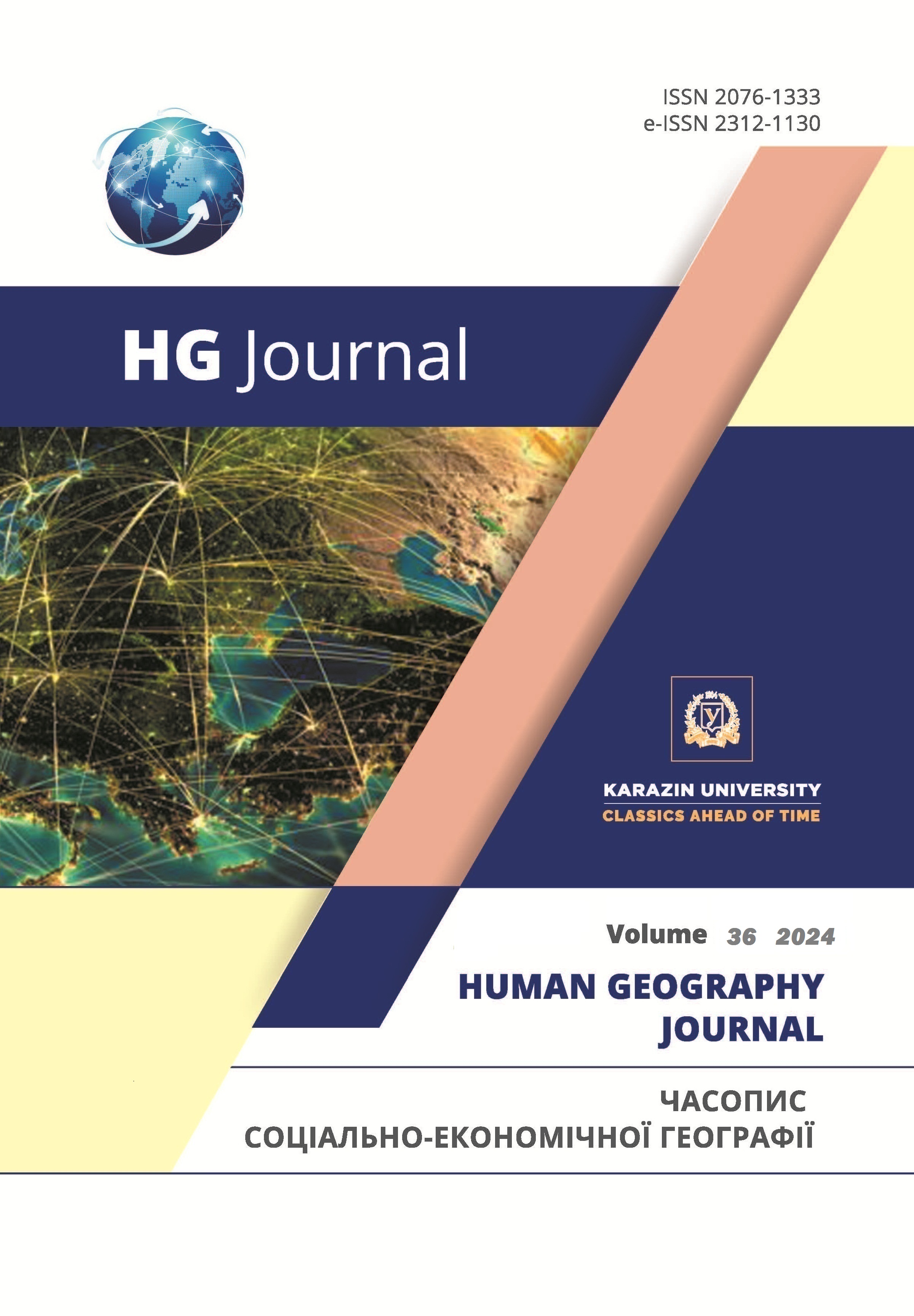Human-geographical features of transport accessibility research of pre-school and secondary education institutions in the cities of Kharkiv and Warsaw
Abstract
An efficient transport system is one of the important elements of an economically developed city. The quality of transport infrastructure and the provision of logistics services primarily contribute to the accessibility or ease with which people can reach their main destinations, such as work, health care and education, using a particular mode of transport, or a combination of these. In the article, a socio-geographical analysis of transport accessibility of preschool and general educational institutions in Kharkiv and Warsaw was carried out. Features of the methodology of transport accessibility research using geoinformation systems QGIS 3.16 and ArcGis 10.7 are presented based on OpenStreetMap data. On the basis of a spatial GIS analysis of the placement of preschool and secondary education institutions, buffer zones were built, which cover the territory in a 500-meter (approximately 5-minute) accessibility zone.
It was established that the cities of Kharkiv and Warsaw have a well-developed transport infrastructure, in the city of Kharkiv the structure of passenger traffic by type of transport is dominated by the subway, in the city of Warsaw - bus transport. A comparative analysis of the accessibility of preschool educational institutions by all types of public transport in Kharkiv and Warsaw showed that, in general, the share of the number of institutions located in buffer zones is practically the same by type of transport. The number of preschool educational institutions in Warsaw is 3.5 times more than in Kharkiv. In the course of the study of the transport accessibility of general educational institutions by all types of public transport in Kharkiv and Warsaw, it was established that, in general, by means of transport, the share of institutions located in buffer zones is almost equal, the number of secondary educational institutions in Warsaw is almost twice as large as in Kharkiv. The number of educational institutions located in buffer zones is almost 90%: out of 215 schools, 213 are located in public transport buffer zones. The majority of educational institutions (99%) in Warsaw are located in the buffer zones of bus routes, which indicates the wide coverage of this mode of transport. The metro provides access to 27% of the city's schools. A significant part of schools (51%) in Warsaw is located in the buffer zones of tram routes, which increases the accessibility of educational institutions.
In general, the cities of Kharkiv and Warsaw are characterized by a fairly high level of transport accessibility to educational infrastructure, since more than 99% of educational institutions are located within the buffer zones of public transport, which confirms the effectiveness of the transport infrastructure of the cities in providing access to preschool and secondary education institutions.
Downloads
References
Behbahani, H., Nazari, S., Jafari K., M., & Litman, T. (2019). A conceptual framework to formulate transportation network design problem considering social equity criteria. Transp. Res. Part A: Policy Pract. 125(C), 171-183.
De Palma, A., Lindsey, R., Quinet, E., & Vickerman, R. (2017). The Routledge Handbook of Transport Economics (Edited ByJonathan Cowie, Stephen Ison). – 1st Edition, 2017, 460.
Fan, W., & Machemehl, R.B. (2011). Bi-level optimization model for public transportation network redesign problem: Accounting for equity issues. Transp. Res. Rec. 2263 (1), 151-162. https://doi.org/10.3141/2263-17.
Malysh, N. (2016). Transport infrastructure of Ukraine under the conditions of implementation of the Association Agreement with the EU. Development of the accounting, analysis and audit system in Ukraine: theory, methodology, organization: materials Vseukr. of science conf., Kyiv: NASOA, 146-149 [in Ukrainian].
Niemets, L., Sehida, K. et.al. (2017). Innovatsiyno-investytsiynyy potentsial yak osnova konkurentospromozhnosti (na prykladi Kharkivsʹkoyi oblasti): kolektyvna monohrafiya [Innovation and investment potential as the basis of competitiveness (case study of Kharkiv region, coll. monograph. Kharkiv], V.N. Karazin Kharkiv National University, 2017, 520 p. [in Ukrainian].
Nosovska, O. (2014). Problems and prospects for the development of transport infrastructure of Ukraine. Bulletin of the Pryazovsky State Technical University, 27, 5-14 [in Ukrainian].
Official website of Warsaw City. Retrieved from https://ua.um.warszawa.pl/ [in Ukrainian].
Official website of Kharkiv City Council, Mayor. Retrieved from https://www.city.kharkov.ua/ [in Ukrainian].
Official website of the Main Department of Statistics in the Kharkiv region. Retrieved from http://kh.ukrstat.gov.ua/
OpenStreetMap. Retrieved from https://www.openstreetmap.org/
OverpassTurbo. Retrieved from https://overpass-turbo.eu/
Public transport step by step. Warsaw Public Transport. Retrieved from https://www.wtp.waw.pl/en/public-transport-step-by-step/ [in Ukrainian].
Raza, A., Zhong, M., Akuh, R., & Safdar, M. (2023). Public transport equity with the concept of time-dependent accessibility using Geostatistics methods, Lorenz curves, and Gini coefficients. Case Studies on Transport Policy, 11, https://doi.org/10.1016/j.cstp.2023.100956
Shiba, O. (2016). Strategy for the development of transport infrastructure of Ukraine in the conditions of European integration. Black Sea Economic Studies, Part 8, 35-40 [in Ukrainian].
Spatial analysis of vector data (Buffer). QGis documentation. Retrieved from https://docs.qgis.org/3.4/ru/docs/gentle_gis_introduction/vector_spatial_analysis_buffers.html
Stachyra, R., & Roman, K. (2021). Analysis of Accessibility of Public Transport in Warsaw in the Opinion of Users. Postmodern Openings, Editura Lumen, Department of Economics, 12(3), 384-403.
Warsaw’s transport. Retrieved from https://yavpohode.net/files/warsaw-strefa [in Ukrainian].
Wu, T.H. (2014). Research on layout planning of town center for public service facilities configuration. Dev. Small Cities Towns, 11 (2014), pp. 39-47.
ZTM annual reports. Public Transport Authority in Warsaw. Retrieved from https://www.ztm.waw.pl/raporty-roczne-ztm/ [in Ukrainian].
Copyright (c) 2024 Kravchenko K., Shpak Ye., Khabusev Ye.

This work is licensed under a Creative Commons Attribution 4.0 International License.




